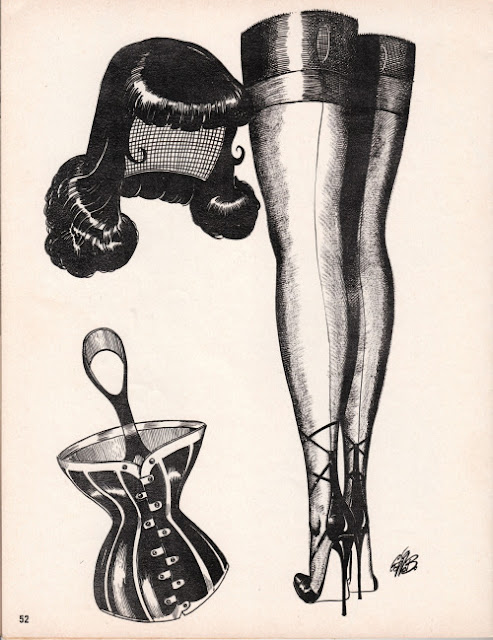


African-American illustrator and artist Eugene Bilbrew was born in Sunny L.A. in 1924. As with most of the illustrators I hope to profile here (see my earlier Bill Alexander post) his life is sketchy. In fact, even his 1974 death of a heroin overdose in the back of minor mobster Eddie Mishkin's bookstore on 42nd Street in Manhattan is poorly documented, especially for an artist whose work has had such an influence. Remarkably, it is known that Bilbrew knew Alexander in Los Angeles before WW2. While Alexander was able to come close to the music business (illustrating 78rpm records for Roy Milton's Miltone label) young Bilbrew actually made it to the stage, if only in a minor role. He somehow finagled himself into temporary membership in "The Basin Street Boys" a LA based Doo Wop group with one hit, the prophetic "I Sold My Heart To The Junkman." The song was later recorded by Patti Labelle and has been performed in concert by no less than Bette Midler and Bruce Springsteen. The group broke up leaving Eugene in New York City (from where I will continue his story in a later post) A warning to the faint...since Bilbrew obviously fell into some bad habits in the Big Apple, you would be correct to assume most of the young black man's talent was directed at artistic pursuits even less, umm..."acceptable" than the lurid sleazy covers of these 1965 paperbacks from my collection, so if you choose to google him up with your preferences open, you might be disturbed. There are literally thousands of entries on Bilbrew and his work on the web, and yet the "real" art world seems to know virtually nothing about him. This may be due to his "way outside the norm" life and body of work, but it could just as easily be due to his race or the fact that virtually none of his original work survives. Although he was accepted into the program at the "Cartoonist and Illustrators School" (later titled the School of Visual Arts in 1956) one suspects his drift into drug addiction and work which was was largely considered pornographic at the time may have been at least partially caused by discrimination. He had a most unusual and completely individual style which emerged from a more traditional genre of cartooning, and once one becomes familiar with his work it is instantly recognizable. The best biographical material on Eugene Bilbrew and other sleaze paperback artists is found in the outstanding 2005 "Sin-A-Rama" book published by Feral House, in particular the entry on Bilbrew by Brittany Daley. This year, Feral Press has also published "Dope Menace: The Sensational World of Drug Paperbacks 1900-1975" by Stephen J. Gertz which is equally as fascinating and even more scholarly but just as much fun.
Six c. 1965 Paperback books, cover illustrations Eugene Bilbrew. Collection Jim Linderman
SEE TIMES SQUARE SMUT THE BOOK HERE














































